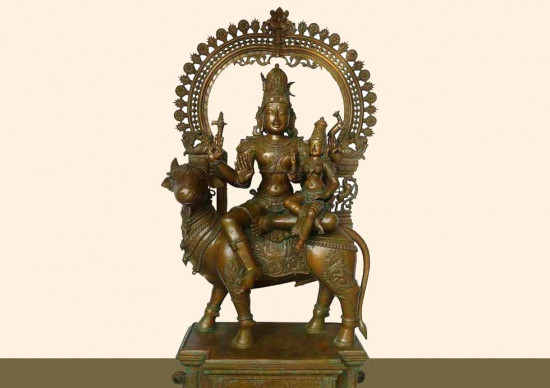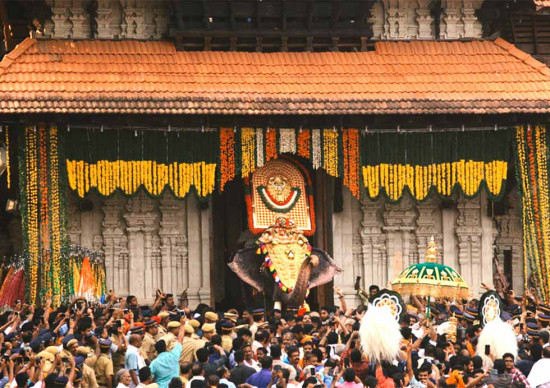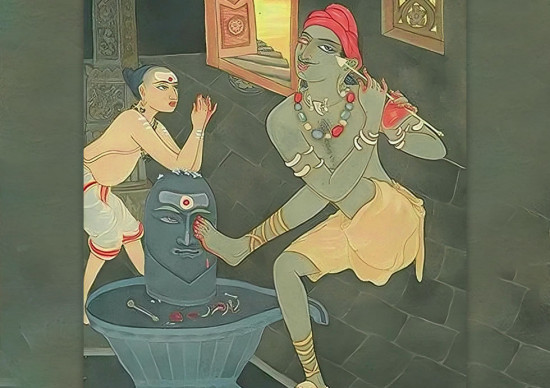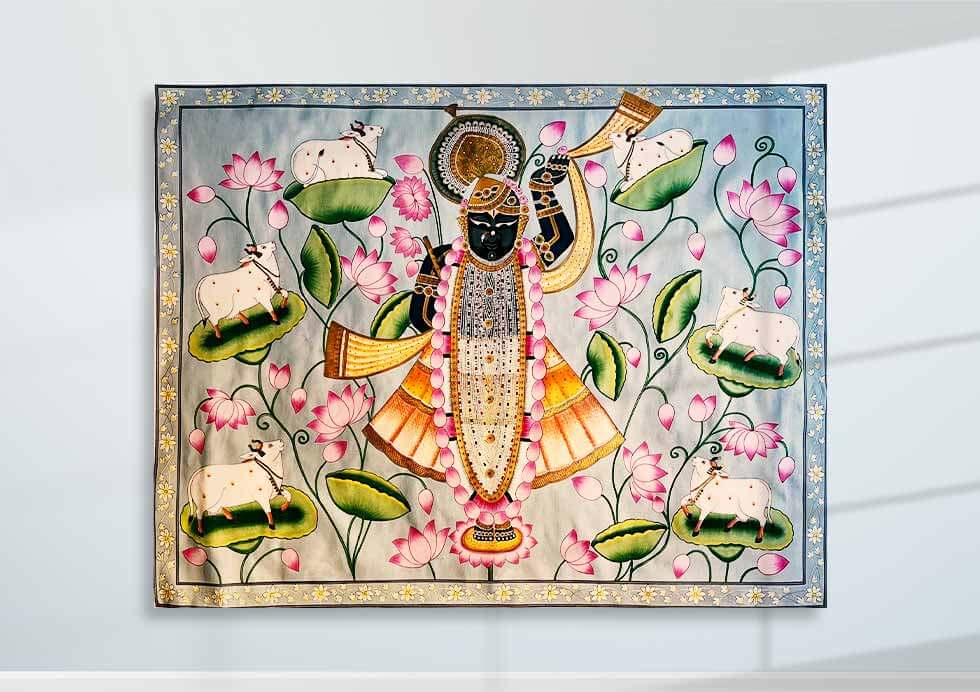
Shrinathji is a revered deity worshiped in the Pushtimarg tradition of Hinduism. Pichwai paintings are intricate and colorful devotional paintings that depict Shrinathji in various moods and settings. These paintings are a significant part of the Shrinathji temple rituals and are considered to be sacred objects.
Who is Lord Shrinathji?
Shrinathji, a manifestation of Lord Krishna, is worshiped at the famous Shrinathji temple in Nathdwara, Rajasthan. Pichwai paintings, on the other hand, are intricate and devotional artworks that depict various aspects of Lord Krishna’s life, particularly his association with Shrinathji.
History of Pichwai Paintings
Pichwai paintings have their origins in the town of Nathdwara in Rajasthan, India. The art form emerged in the 17th century and flourished as a way to visually narrate the stories of Lord Krishna, particularly focusing on his childhood exploits. The name “Pichhwai” comes from the Sanskrit words ‘pichh’ meaning back and ‘wais’ meaning hanging, as th
The Miraculous Appearance of the Shrinathji Idol
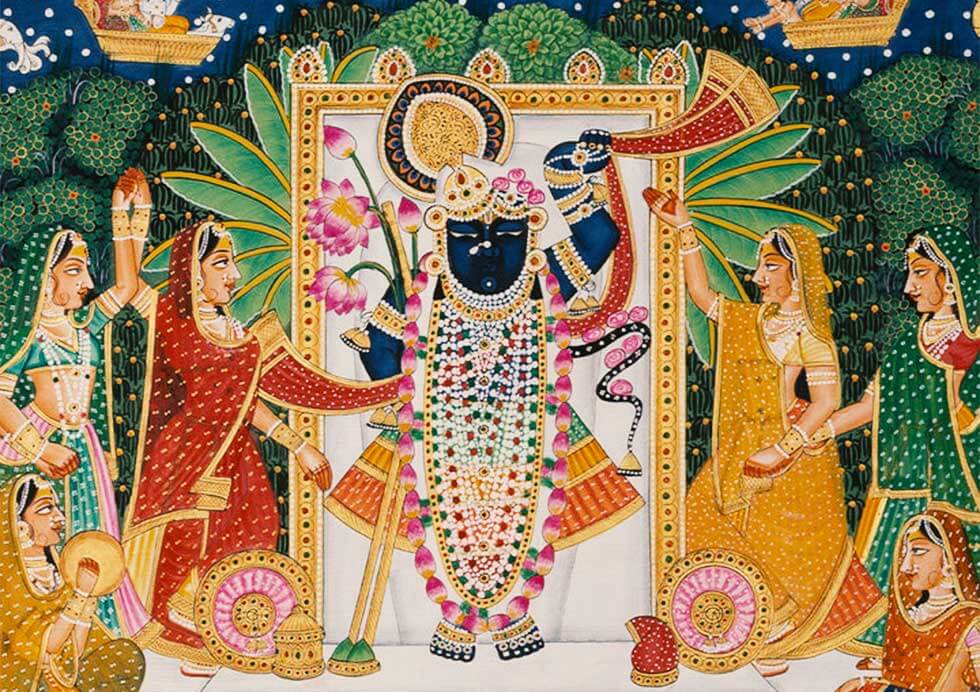
In the sacred town of Govardhan, nestled amidst the divine ambiance of Lord Krishna’s leela (divine play), a unique event unfolded that would forever transform the spiritual landscape.
Legend has it that the deity of Shrinathji miraculously emerged from the sacred Govardhan Hill. The exact details vary in different versions, but a common thread weaves through these narratives, emphasizing the divine nature of the idol.
One version suggests that a cowherd named Madhavendra Puri, an ardent devotee of Lord Krishna, dreamt of the hidden deity. In this vision, he received instructions to unearth the deity from beneath Govardhan Hill and establish its worship.
Following the dream’s guidance, Madhavendra Puri, accompanied by fellow devotees, commenced the search on Govardhan Hill. To their astonishment and delight, they uncovered a captivating idol of Lord Krishna. The idol, adorned with enchanting features, revealed the divine presence of Shrinathji.
Another version narrates that the local villagers stumbled upon the idol while grazing their cattle. The cows, it is said, would regularly visit the spot and return with their milk completely consumed, indicating a divine presence. Intrigued by this mysterious happening, the villagers discovered the idol and recognized it as the manifestation of Lord Krishna. Regardless of the specific details, the essence of the story remains consistent – the idol of Shrinathji emerged miraculously, drawing devotees into a profound connection with the divine.
Legend has it that the deity of Shrinathji miraculously emerged from the sacred Govardhan Hill. The exact details vary in different versions, but a common thread weaves through these narratives, emphasizing the divine nature of the idol.
One version suggests that a cowherd named Madhavendra Puri, an ardent devotee of Lord Krishna, dreamt of the hidden deity. In this vision, he received instructions to unearth the deity from beneath Govardhan Hill and establish its worship.
Following the dream’s guidance, Madhavendra Puri, accompanied by fellow devotees, commenced the search on Govardhan Hill. To their astonishment and delight, they uncovered a captivating idol of Lord Krishna. The idol, adorned with enchanting features, revealed the divine presence of Shrinathji.
Another version narrates that the local villagers stumbled upon the idol while grazing their cattle. The cows, it is said, would regularly visit the spot and return with their milk completely consumed, indicating a divine presence. Intrigued by this mysterious happening, the villagers discovered the idol and recognized it as the manifestation of Lord Krishna. Regardless of the specific details, the essence of the story remains consistent – the idol of Shrinathji emerged miraculously, drawing devotees into a profound connection with the divine.
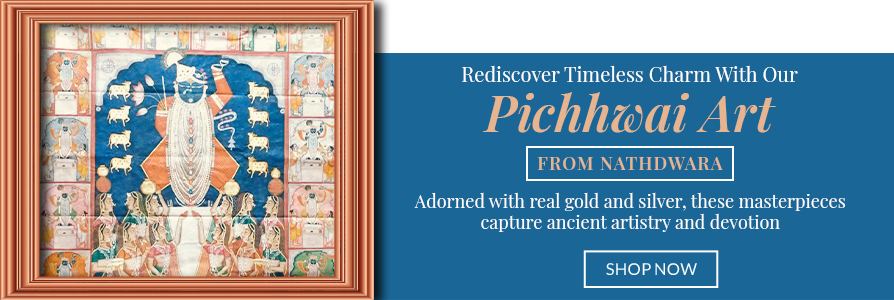
Recognizing the sanctity of the idol, the devotees, under the leadership of Madhavendra Puri, established a temple to enshrine Shrinathji. Over time, this sacred place became a focal point of devotion and pilgrimage, drawing people from near and far to witness and worship the divine manifestation of Lord Krishna in the form of Shrinathji.
The idol’s discovery and subsequent veneration at the Shrinathji Temple in Nathdwara stand as a testament to the extraordinary and miraculous connection between the divine and the devoted. Devotees continue to celebrate and seek blessings from Shrinathji through vibrant artistic expressions like Pichwais.
In Pushtimarg devotional tradition, Pichwais are traditionally hung behind the idol of Shrinathji. These paintings serve a dual purpose: they not only enhance the visual beauty of the temple setting but also act as a visual narrative for devotees, particularly those who are illiterate. Pichwai art is vibrant expressions of faith and artistic talent. These large, cloth-based artworks primarily depict the life and stories of Krishna, a central figure in Hinduism.
Temples typically possess collections of various Pichwais, each showcasing different scenes from Krishna’s life. These pichhwai paintings are carefully rotated throughout the year to correspond with the specific festivals and celebrations dedicated to the deity. Additionally, regions like Aurangabad also have a historical association with the creation of these unique art pieces.
The idol’s discovery and subsequent veneration at the Shrinathji Temple in Nathdwara stand as a testament to the extraordinary and miraculous connection between the divine and the devoted. Devotees continue to celebrate and seek blessings from Shrinathji through vibrant artistic expressions like Pichwais.
In Pushtimarg devotional tradition, Pichwais are traditionally hung behind the idol of Shrinathji. These paintings serve a dual purpose: they not only enhance the visual beauty of the temple setting but also act as a visual narrative for devotees, particularly those who are illiterate. Pichwai art is vibrant expressions of faith and artistic talent. These large, cloth-based artworks primarily depict the life and stories of Krishna, a central figure in Hinduism.
Temples typically possess collections of various Pichwais, each showcasing different scenes from Krishna’s life. These pichhwai paintings are carefully rotated throughout the year to correspond with the specific festivals and celebrations dedicated to the deity. Additionally, regions like Aurangabad also have a historical association with the creation of these unique art pieces.
Starting Of Pichwai Paintings
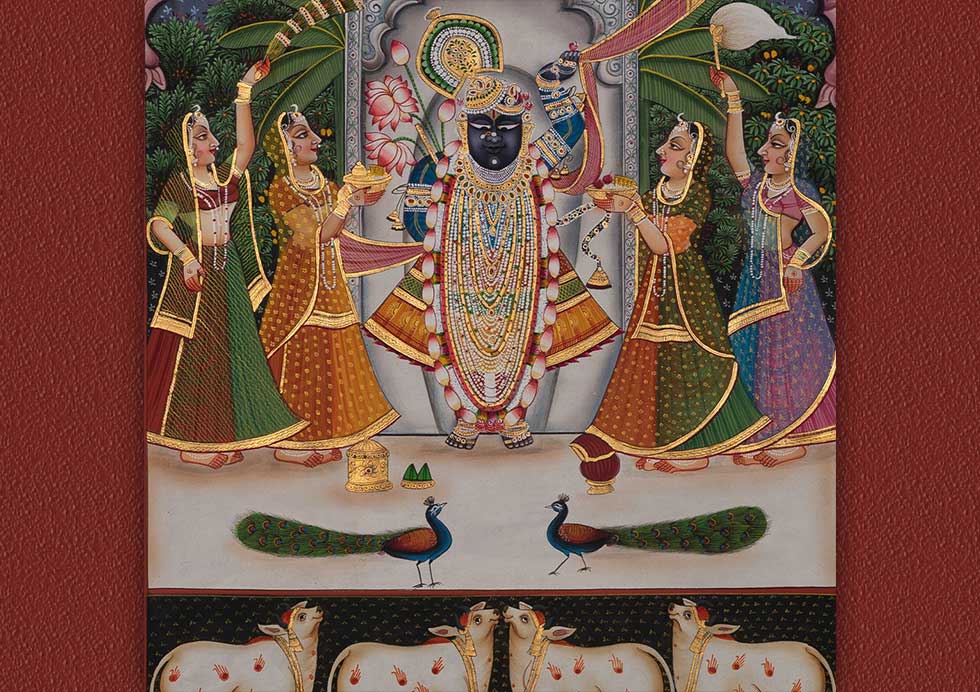
In 1672 CE, when the Shrinathji temple was established, the tradition of crafting Pichwai painting began under the guidance of Vitthalnath, the chief priest and son of Vallabhachrya, the founder of the Pushtimarg sect. Artisans, commissioned by the chief priest, meticulously created these intricate artworks for religious worship and ceremonies.
Originally, Pichwai art was exclusively made on commission, primarily for the Shrinathji temple. Over time, as the sect expanded to places like Gujarat and Mathura, the art form found its way to these regions. Pilgrims began taking Pichwai paintings from the Shrinathji temple, and wealthy families also commissioned these exquisite pieces. The art’s elaborate nature made it a favorite among theater companies, with production companies often commissioning Pichwais paintings as backdrops for their shows.
Moving into the 19th century, westernized art school painting styles gained popularity among the Indian elite. To sustain the demand for Pichwai art, artisans adapted their techniques. While still maintaining the traditional style, they incorporated Western influences such as the use of oil paints and realism. Noteworthy shifts included adopting the Western art technique of Foreshortening for drawing feet, particularly those of Shrinathji. Despite these changes, the era also witnessed a strong influence from movements like the Swadeshi movement, emphasizing support for traditional Indian art. This, coupled with the inherently religious nature of Pichhwai, prompted many artists to adhere to traditional techniques.
In modern times, Pichwais have become a significant export of Nathdwara, drawing interest from foreign visitors. These artworks, often crafted in the close-knit community of Chitron ki gali and Chitrakaron ka mohalla, have evolved into a group effort. Skilled painters collaborate under the guidance of a master artist. Initially, these paintings are hung behind the idol in the temple, symbolizing their sacred significance.
The process of creating Pichwais begins with the artist closely observing the idol, capturing its divine essence. The intricate details, vibrant colors, and traditional patterns associated with Pichwai art is carefully incorporated. In recent times, there has been a concerted effort by artists and designers to preserve and showcase this art form on international platforms. Traditional colors, printing techniques, and patterns from Pichwai art have found expression in clothing attires, gaining recognition at events like Lakmé Fashion Week.
Originally, Pichwai art was exclusively made on commission, primarily for the Shrinathji temple. Over time, as the sect expanded to places like Gujarat and Mathura, the art form found its way to these regions. Pilgrims began taking Pichwai paintings from the Shrinathji temple, and wealthy families also commissioned these exquisite pieces. The art’s elaborate nature made it a favorite among theater companies, with production companies often commissioning Pichwais paintings as backdrops for their shows.
Moving into the 19th century, westernized art school painting styles gained popularity among the Indian elite. To sustain the demand for Pichwai art, artisans adapted their techniques. While still maintaining the traditional style, they incorporated Western influences such as the use of oil paints and realism. Noteworthy shifts included adopting the Western art technique of Foreshortening for drawing feet, particularly those of Shrinathji. Despite these changes, the era also witnessed a strong influence from movements like the Swadeshi movement, emphasizing support for traditional Indian art. This, coupled with the inherently religious nature of Pichhwai, prompted many artists to adhere to traditional techniques.
In modern times, Pichwais have become a significant export of Nathdwara, drawing interest from foreign visitors. These artworks, often crafted in the close-knit community of Chitron ki gali and Chitrakaron ka mohalla, have evolved into a group effort. Skilled painters collaborate under the guidance of a master artist. Initially, these paintings are hung behind the idol in the temple, symbolizing their sacred significance.
The process of creating Pichwais begins with the artist closely observing the idol, capturing its divine essence. The intricate details, vibrant colors, and traditional patterns associated with Pichwai art is carefully incorporated. In recent times, there has been a concerted effort by artists and designers to preserve and showcase this art form on international platforms. Traditional colors, printing techniques, and patterns from Pichwai art have found expression in clothing attires, gaining recognition at events like Lakmé Fashion Week.

